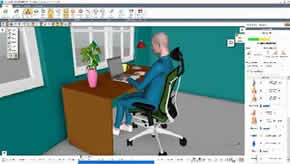
Overview
Ergonomic simulation is a powerful tool that can significantly enhance company competitiveness and boost productivity. By focusing on the well-being and comfort of employees, companies can foster a more motivated and efficient workforce. This approach involves designing workplaces that meet ergonomic standards, ensuring that employees can perform their tasks comfortably and without pain.
Importance of Ergonomics in the Workplace
A satisfied employee is a productive employee. When workers are comfortable and free from physical strain, they are more likely to be focused, motivated, and efficient. Ergonomically designed workplaces contribute to this by minimizing the risk of injury and discomfort. This not only improves individual performance but also has a positive impact on overall company productivity.
Benefits of Ergonomic Simulation
- Enhanced Employee Satisfaction: Ergonomic simulation helps identify potential issues in workplace design that could lead to discomfort or injury. By addressing these issues, companies can create a more pleasant working environment, leading to higher employee satisfaction.
- Increased Productivity: When employees are comfortable, they can work more efficiently and with greater focus. Ergonomic simulation allows companies to optimize workplace performance, unlocking reserves of productivity that might otherwise remain untapped.
- Long-Term Productivity Gains: Investing in ergonomic design has long-term benefits. It reduces the likelihood of work-related injuries and absenteeism, ensuring that employees can maintain high levels of productivity over time.
How Ergonomic Simulation Works
Ergonomic simulation involves using advanced software to model and analyze workplace environments. This technology can simulate various aspects of the workplace, including the physical layout, the interaction between employees and their workstations, and the potential strain on different parts of the body. By analyzing these factors, companies can make informed decisions about how to improve their workspaces.
Case Study: Vivelab Ergo
A detailed case study on Vivelab Ergo illustrates the impact of ergonomic simulation on workplace design and productivity. The study demonstrates how Vivelab Ergo used ergonomic simulation to identify and address issues in their workplace, leading to significant improvements in employee comfort and productivity.
- Identifying Problem Areas: The simulation highlighted areas where employees were experiencing discomfort or strain. This allowed Vivelab Ergo to make targeted improvements to their workplace design.
- Implementing Solutions: Based on the findings from the simulation, Vivelab Ergo made several changes to their workplace layout and equipment. These changes included adjusting workstation heights, redesigning seating arrangements, and improving lighting conditions.
- Measuring Impact: After implementing the changes, Vivelab Ergo saw a noticeable increase in employee satisfaction and productivity. The simulation provided a clear roadmap for creating a more ergonomic and efficient workplace.
Conclusion
Ergonomic simulation is a valuable tool for any company looking to enhance its competitiveness and productivity. By prioritizing employee comfort and well-being, companies can unlock significant productivity gains and create a more motivated workforce. The case study on Vivelab Ergo highlights the tangible benefits of this approach, demonstrating how ergonomic simulation can lead to long-term improvements in workplace performance.
For a more detailed understanding of how ergonomic simulation can benefit your company, read the full case study here: Ergonomic Simulations – Vivelab Ergo Case Study.
This comprehensive document offers insights into the methodologies employed, the results obtained, and the positive impact on employee satisfaction and productivity. By embracing ergonomic simulation, companies can create healthier, more efficient work environments that drive success.
